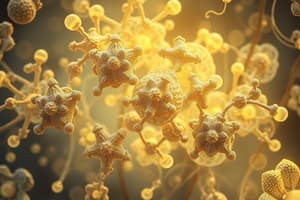Podcast
Questions and Answers
What is the primary role of lipids in biological systems?
What is the primary role of lipids in biological systems?
- Synthesizing proteins
- Energy storage and cellular signaling (correct)
- Transporting oxygen in the blood
- Catalyzing biochemical reactions
Which statement correctly describes the nature of enzymes?
Which statement correctly describes the nature of enzymes?
- Enzymes are usually made up of nucleotides.
- Enzymes are large molecules typically 20 kDa or more. (correct)
- Enzymes are typically small molecules less than 20 kDa.
- Enzymes do not participate in biochemical reactions.
What is a key product of the herb Artemisia Annual?
What is a key product of the herb Artemisia Annual?
- Artemisinin (correct)
- Polyethylene terephthalate (PET)
- Hydroxypropylphosphonic acid
- Sitaglip6n
What is a common feature of biocatalysts?
What is a common feature of biocatalysts?
Which molecule is responsible for the energy storage and cell structural integrity in organisms?
Which molecule is responsible for the energy storage and cell structural integrity in organisms?
What is the primary role of phospholipids in biological membranes?
What is the primary role of phospholipids in biological membranes?
Which feature characterizes a semipermeable membrane?
Which feature characterizes a semipermeable membrane?
What is the significance of ΔG being negative in spontaneous processes?
What is the significance of ΔG being negative in spontaneous processes?
What type of bilayer is found in the cell membrane?
What type of bilayer is found in the cell membrane?
Which of the following is NOT a function of the cell membrane?
Which of the following is NOT a function of the cell membrane?
How do proteins interact with the lipid bilayer?
How do proteins interact with the lipid bilayer?
What process leads to the formation of the cell membrane?
What process leads to the formation of the cell membrane?
Which of the following accurately describes the cell membrane?
Which of the following accurately describes the cell membrane?
Flashcards are hidden until you start studying
Study Notes
Phospholipids and Cell Membrane Structure
- Phospholipids form the fundamental structure of cell membranes, creating a bilayer that protects cellular integrity.
- The presence of water promotes the self-assembly of phospholipids into bilayers due to hydrophobic and hydrophilic interactions.
Functions of Cell Membrane
- Provides shape and structural support to cells.
- Facilitates transport of molecules through active and passive mechanisms.
- Plays a vital role in cell-cell communication via signaling molecules.
- Separates internal cellular components from the external environment while allowing selective permeability.
Types of Lipids
- Fat Types: Include triglycerides, which serve as major energy storage units.
- Fatty Acids: Can be categorized into saturated and unsaturated varieties; both play crucial roles in cell membrane integrity and energy storage.
- Good Fatty Acids: Certain unsaturated fatty acids are beneficial for health and can have positive effects on cellular functions.
Biological Membranes
- Biological membranes are a dynamic assembly of lipids and proteins, exhibiting a fluid mosaic model.
- Membranes require a balance between rigidity and fluidity to function effectively under various physiological conditions.
Importance of Enzymes in Biocatalysis
- Enzymes, typically large molecules (≥20 kDa), are critical for biochemical reactions, acting as catalysts to increase reaction rates.
- Proteins are constructed from amino acids linked through peptide bonds, forming the active components of enzymes.
Synthesis of Artemisinin
- Artemisinin is derived from the herb Artemisia annua and requires specific growing conditions such as optimal weather, land, and water resources.
- The synthesis of this compound is significant in pharmaceuticals, particularly for malaria treatment.
Polyethylene Terephthalate (PET)
- PET is a type of polymer used in various applications, including textiles and containers, highlighting the versatility of biopolymers.
Overview of Lipids
- Lipids consist of fatty acid monomers responsible for energy storage, maintaining cell structural integrity, and facilitating cellular signaling.
Studying That Suits You
Use AI to generate personalized quizzes and flashcards to suit your learning preferences.





